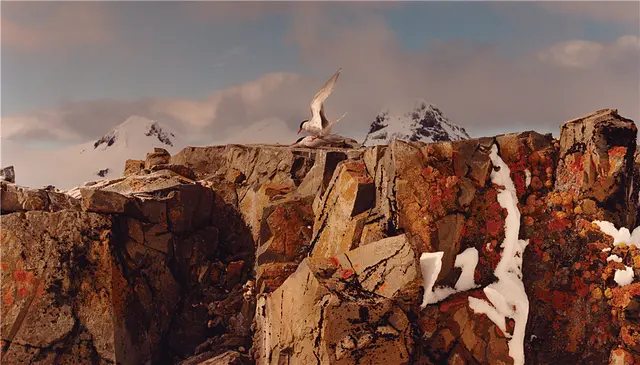(THE WALL STREET JOURNAL)Late November,the first commercial airliner touched down on an icy strip of Antarctica. It took a little while for the news to reach the rest of the world, which reacted with a mix of marvel and trepidation. A Boeing 757 with 62 business-class seats had crossed the stormy waters between Chile and the Union Glacier without so much as a bump. Antarctica—the remote, impossible terrain of Scott and Amundsen and Shackleton only a century ago—is now a day trip. Antarctica will never be the same.
BEFORE SUNSET | During Antarctica’s summer, which starts in October, a permanent dusk reigns in the evening—as seen here from the deck of the Quark Expeditions ship Ocean Endeavour, at the Drake Passage.PHOTOGRAPHY BY JAMIE HAWKESWORTH FOR WSJ. MAGAZINE
The truth is, Antarctica has never been the same. It’s almost unfair to call it the seventh continent, even if that’s how many travelers see it, the last item on a bucket list. Antarctica is more like a second Earth. It is the closest any but a handful of us alive today will get to setting foot on another planet, and although it’s more accessible than it’s ever been, we will never conquer it. Antarctica’s forbidding landscape is, in essence, a vast collection of ice in all its shapes, forms and densities, surrounded by water that was either just ice or is about to become ice again. It is a thousand shades of blue, from near pitch-black to the most brilliant turquoise, capped with a hundred shades of white. Depending on the time of year, the sun might never set or never rise. Our tenuous, alien settlements there are still no match for penguin colonies filled with tens of thousands of residents, or the associations of humpback whales whose singing is rivaled only by the howling of the ice itself. There are wandering albatrosses there with 11-foot wingspans. Everything in and about Antarctica is big.
DEEP FREEZE | The age of an iceberg—like this one, off the shore of Deception Island—can be approximated by its shape. Young icebergs feature jagged contours, while older ones have more sculptural, flowing lines. Antarctica’s largest icebergs can be as big as Texas and weigh billions of tons.PHOTOGRAPHY BY JAMIE HAWKESWORTH FOR WSJ. MAGAZINE
Seeing your ship dwarfed by the face of a glacier, or feeling its hull shudder and groan when it deflects a growler the size of a car, does something to your head, as does watching an iceberg bigger than an entire neighborhood roll over and launch a wave that would flood a fourth-floor office. After you’ve seen a pod of killer whales conspire like wolves to pluck a doomed seal off the bone-littered shore in front of your eyes, try looking in the mirror and calling yourself a hunter.
LOVE IN A COLD CLIMATE* | Two arctic terns mating at Half-Moon Island. The birds, native to the far Northern Hemisphere, migrate to Antarctica during the winter months. PHOTOGRAPHY BY JAMIE HAWKESWORTH FOR WSJ. MAGAZINE*
Of course, humanity is leaving its mark on this seemingly invincible place. Antarctica has always advanced and retreated with the seasons, but it’s retreating more than it ever has. In 2014, two separate teams of scientists declared thecollapse of the massive West Antarctic ice sheet inevitable. Antarctica has never been static, but now, owing to the effects of global warming, itchanges more dramatically, with more conviction. While leaving jet-tire marks on its glaciers is a kind of miracle, it’s also just more vandalism.
All the more reason why it’s oddly comforting to go there and be awed, and why traveling by ship will always be better than shortcutting by plane. (Dozens of cruises visit during the austral summer, between late October and March, many departing from Ushuaia, Argentina, the world’s southernmost city.) It’s easier to care about a place after you’ve touched it—and easier still after it has touched you. Stand in the middle of all that upheaval and melt, float in a kayak at the source of our rising seas, and you’ll feel less like an agent of change and more like the object of it. You’re the one who will never be the same.
 简体中文
简体中文





